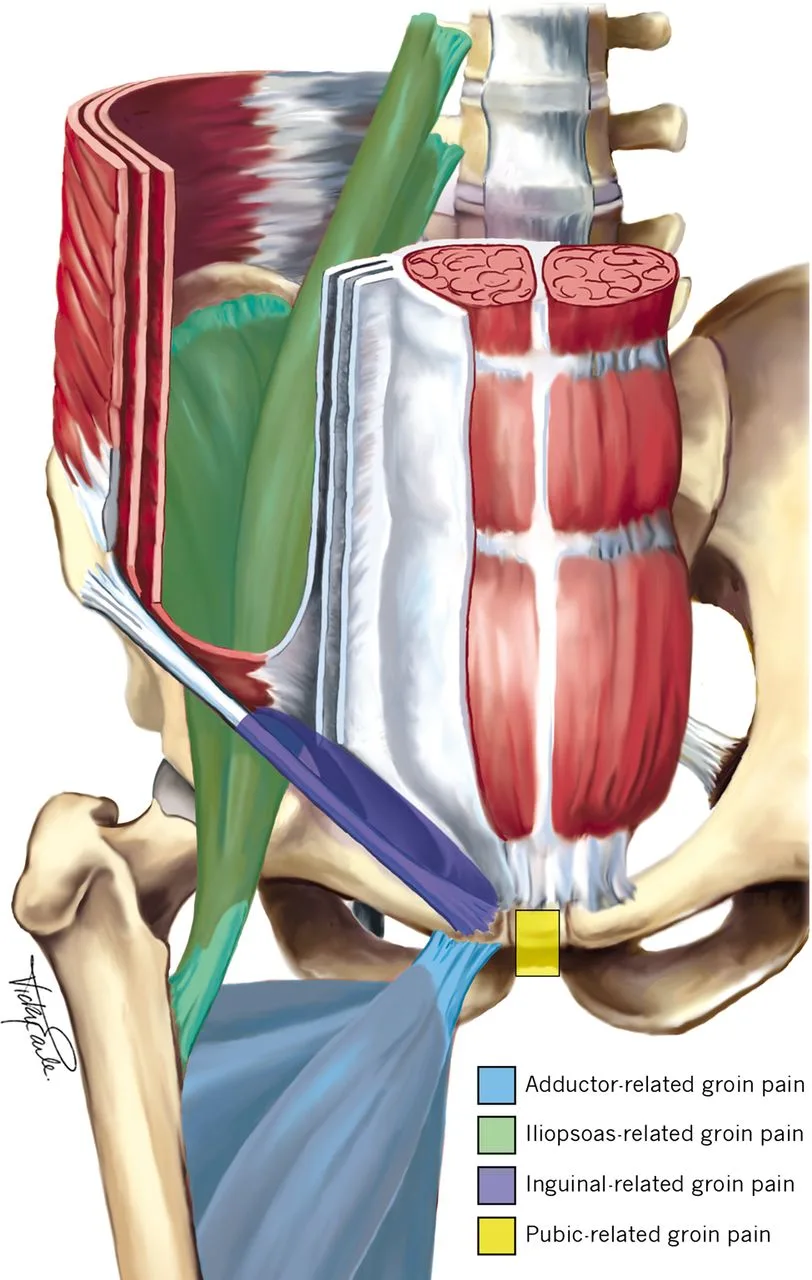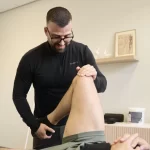Groin pain in athletes - Physiotherapy helps you further
At Fysio Fitaal, we regularly see athletes with groin pain. A common injury in explosive sports such as football, athletics or hockey. But think also of strength sports where a lot is done with maximum effort. It is an area where several structures come together. It is precisely this complexity that makes the groin vulnerable during sports and often challenging to diagnose clearly. At Fysio Fitaal in Tilburg, we are convinced that the success of treatment largely depends on making the right diagnosis. When we know which structure is responsible for the symptoms, we can start a targeted and substantiated rehabilitation. This is especially true for the final phase of rehabilitation: when the athlete returns to the field or sport. This is where a more targeted and sport-specific approach is needed than in the initial phase of rehabilitation.

Anatomy of the groin region
We describe the groin region as the transition from the trunk to the leg. It is an area where many structures converge. Muscles attach in this region from different directions. The main muscle groups located here are the adductors, the hip flexors (such as the iliopsoas and rectus femoris) but also the abdominal muscles that attach to the pubic bone. Each of these structures individually, but also in combination, can be responsible for groin pain.
What characterises this region is that it plays a central role in the transfer of forces between the upper and lower body. Movements such as sprinting or lateral acceleration must be able to work together efficiently in this system. Once there is reduced control or overload in one part, the chain can be vulnerable to injury. The groin region is therefore a place where many forces have to be transferred. An injury is then often the result of a long-standing functional limitation.
From broad understanding to greater insight using the DOHA agreement as a compass
An important development in understanding groin pain was the publication of the Doha Agreement in 2015 (Weir et al.). In this international agreement, a clear subdivision of groin pain-related complaints was made for the first time. Instead of a generic term such as sports groin, for example, a distinction is now made between five recognisable anatomical structures:
- adductor-related pain
- iliopsoas-related pain
- inguinal groin pain
- pubis-related pain
- intra-articular problems of the hip
- Other causes such as possibly autoimmune diseases or complaints of the bladder or genitals
Being able to properly distinguish these structures allows us to treat in a much more targeted way. Therefore, we base our clinical assessment not only on the location of the pain, but also on the functional overall picture: how does someone move, what forces are acting on the body and where do things go wrong in the chain? The Doha classification helps us as a framework, but it is the combination of experience, anatomical knowledge and analysis that makes the difference. By keeping this in mind with every athlete with groin problems, we ensure that we are really working on the injury at the core of the problem.
Ultrasound as diagnostic spearhead
Ultrasound offers unique advantages when assessing groin pain. It allows us to gain immediate and low-threshold insight into which muscle or tendon structures are affected, without the need for a referral. Especially with complaints that are difficult to pinpoint, ultrasound is a valuable addition to the interview and physical examination. When the pain picture cannot be properly explained by the tests from the physical examination, we use ultrasound to do additional research into possible changes. Ultrasound allows us to accurately visualise the groin region. Among other things, we assess the adductors, iliopsoas and rectus femoris for signs of strain, swelling or possible tears. Possible bursas and the inguinal canal are clearly visible, which helps rule out an inguinal hernia or abdominal wall instability.
As with the hamstrings, where an injury to the central tendon often accompanied by a longer recovery time, a similar central tendon structure also exists in the adductor group. In particular, the adductor longus attaches to a common tendon plate on the pubic bone along with other muscles such as the adductor brevis and gracilis. This common adductor origin is prone to injury, especially during explosive movements such as kicking or sprinting. The exact location of the injury is critical to the expected recovery. Injuries closer to the insertion or within the central tendon structure require longer, more gradual rehabilitation than more superficial injuries.
Ultrasound can also give more insight into the severity of the injury. By looking at the images together and explaining what we see, there is a greater understanding of the symptom picture as well as the reason behind a particular treatment. More importantly: the expected prognosis. This strengthens the athlete's involvement in the recovery process, something we at Fysio Fitaal consider very important for a sustainable recovery.
Doing it yourself
Treating groin pain requires a lot from the athlete himself. While techniques such as dry needling, massage and NSAIDs can provide relief, they are never the basis for complete rehabilitation. Full recovery from a groin injury requires a thoughtful approach aimed at restoring strength, control and function in this region. Central to our approach is increasing tissue capacity, aka the load capacity of these structures. The load capacity of muscle and tendon structures should be built up step by step, tailored to the stage of recovery. Here, we use progressive exercise therapy with a focus on the muscle group involved in the complaints.
For adductors, we regularly use the Copenhagen Protocol. This is a science-based programme aimed at improving adductor strength and control. This protocol is not only useful during rehabilitation, but like the nordic hamstring curl, this programme has value not only in recovery, but certainly also in prevention. Several studies show that when athletes perform these exercises regularly, they are less likely to have recurrent groin problems.
Step by step towards sustainable recovery
Sustainable recovery starts with a clear, transparent diagnosis and a plan tailored to the athlete and the structure involved. At Fysio Fitaal Tilburg, we combine our experience in sports rehabilitation with evidence-based training principles. We guide our athletes step by step towards a responsible return to sport. Whether that is on a recreational, competitive or professional level. We believe that true recovery is more than being pain-free. It is being prepared for the strain of sport without relapse, full focus and with confidence in your body.

Related complaints


Lies complaints
Groin pain is common in athletes. Especially in sports where many changes in speed...

